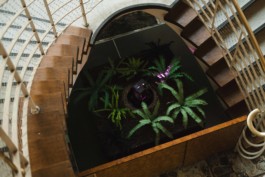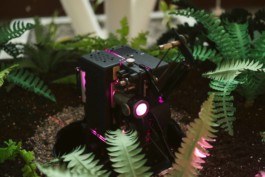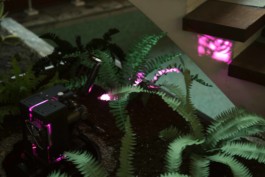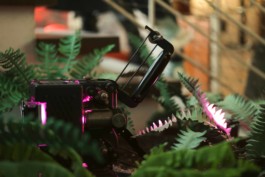




1.)
The End of the Human Eyes
16mm projector | UV grow LED COB chip | potted ferns | motorized rotating base | light, humidity, temperature, movement sensors | 2024
This system is an interactive installation where a group of ferns are equipped with a network of sensors capable of detecting environmental stimuli such as light intensity, humidity, temperature, or even subtle movements of the plants. These sensors are connected to a central processing chip, which continuously collects and analyzes the data from the ferns. The sensory data reflects the environmental conditions experienced by the plants in real time.
In the center of the ferns is a 16mm projector, which is equipped with a UV grow light LED source. The chip interprets the input from the ferns and translates it into commands that control two aspects of the projector’s behavior: the speed at which it rotates and the speed at which the UV grow light flickers. The more intense the data from the ferns (such as higher humidity or sudden movement), the faster the projector spins and the more rapid the flickering of the UV grow light. Conversely, calmer, less intense environmental conditions result in slower rotations and gentler flickering.
This creates an immersive and dynamic interaction between the living ferns and the mechanical projector, allowing the plants to "communicate" their sensory experiences through light and movement. The installation brings together organic and technological elements, blurring the line between nature and machine, as the environmental states of the plants directly shape the behavior of the UV-lit projection in a continuous, ever-evolving loop.
This system can be seen as a type of "cinema for plants" because it creates a loop where the ferns, through their sensory input, influence the visual and experiential output in real time. Unlike traditional cinema, where the audience is passive and receives pre-programmed content, this setup gives plants an active role in shaping the cinematic experience.
From the plants' perspective, this UV grow light flickering and movement would be the equivalent of a film—an ongoing visual experience generated specifically by and for their own environmental interactions. The changing rhythm of light and motion mirrors how human cinema uses light, shadow, and movement to create a visual narrative. Here, the narrative is not pre-recorded but emerges organically from the plants' own experiences, resulting in a responsive, ever-changing form of plant-centric cinema.
Thus, this installation could be seen as a kind of "bio-cinema," where plants are no longer passive viewers but active participants in their own version of visual storytelling. They are both the creators and the audience of a light performance, making this a uniquely symbiotic, plant-driven form of cinema.*
*While the UV light used in this plant cinema is integral to creating a unique sensory experience for the ferns, it’s important to note that prolonged exposure to UV radiation can be harmful to humans. UV light, particularly in high intensities, has been linked to skin damage and an increased risk of skin cancer. In addition to the risk of skin damage, it’s crucial to avoid staring directly at the UV light emitted by the projector, as this can cause severe eye damage. Prolonged exposure or direct gazing into the UV light can result in conditions similar to those caused by staring directly at the sun, such as corneal burns, cataracts, and even long-term vision loss or blindness. For this reason, humans should avoid spending extended periods in close proximity to the UV-lit projector. The system is designed with plants in mind, and while it creates an immersive, plant-centric environment, human visitors should be mindful of these risks and take precautions to protect both their skin and eyes by limiting their exposure to the UV light and avoiding direct visual contact.
This project was funded by a research grant from the State of Berlin.
Image Reference
1.) Diffraktion; Berlin Germany 2025
© Felix Stepp





1.)
The End of the Human Eyes
16mm projector | UV grow LED COB chip | potted ferns | motorized rotating base | light, humidity, temperature, movement sensors | 2024
This system is an interactive installation where a group of ferns are equipped with a network of sensors capable of detecting environmental stimuli such as light intensity, humidity, temperature, or even subtle movements of the plants. These sensors are connected to a central processing chip, which continuously collects and analyzes the data from the ferns. The sensory data reflects the environmental conditions experienced by the plants in real time.
In the center of the ferns is a 16mm projector, which is equipped with a UV grow light LED source. The chip interprets the input from the ferns and translates it into commands that control two aspects of the projector’s behavior: the speed at which it rotates and the speed at which the UV grow light flickers. The more intense the data from the ferns (such as higher humidity or sudden movement), the faster the projector spins and the more rapid the flickering of the UV grow light. Conversely, calmer, less intense environmental conditions result in slower rotations and gentler flickering.
This creates an immersive and dynamic interaction between the living ferns and the mechanical projector, allowing the plants to "communicate" their sensory experiences through light and movement. The installation brings together organic and technological elements, blurring the line between nature and machine, as the environmental states of the plants directly shape the behavior of the UV-lit projection in a continuous, ever-evolving loop.
This system can be seen as a type of "cinema for plants" because it creates a loop where the ferns, through their sensory input, influence the visual and experiential output in real time. Unlike traditional cinema, where the audience is passive and receives pre-programmed content, this setup gives plants an active role in shaping the cinematic experience.
From the plants' perspective, this UV grow light flickering and movement would be the equivalent of a film—an ongoing visual experience generated specifically by and for their own environmental interactions. The changing rhythm of light and motion mirrors how human cinema uses light, shadow, and movement to create a visual narrative. Here, the narrative is not pre-recorded but emerges organically from the plants' own experiences, resulting in a responsive, ever-changing form of plant-centric cinema.
Thus, this installation could be seen as a kind of "bio-cinema," where plants are no longer passive viewers but active participants in their own version of visual storytelling. They are both the creators and the audience of a light performance, making this a uniquely symbiotic, plant-driven form of cinema.*
*While the UV light used in this plant cinema is integral to creating a unique sensory experience for the ferns, it’s important to note that prolonged exposure to UV radiation can be harmful to humans. UV light, particularly in high intensities, has been linked to skin damage and an increased risk of skin cancer. In addition to the risk of skin damage, it’s crucial to avoid staring directly at the UV light emitted by the projector, as this can cause severe eye damage. Prolonged exposure or direct gazing into the UV light can result in conditions similar to those caused by staring directly at the sun, such as corneal burns, cataracts, and even long-term vision loss or blindness. For this reason, humans should avoid spending extended periods in close proximity to the UV-lit projector. The system is designed with plants in mind, and while it creates an immersive, plant-centric environment, human visitors should be mindful of these risks and take precautions to protect both their skin and eyes by limiting their exposure to the UV light and avoiding direct visual contact.
Dieses Projekt wurde durch ein Recherchestipendium des Landes Berlin gefördert.
Image Reference
1.) Diffraktion; Berlin Germany 2025
© Felix Stepp